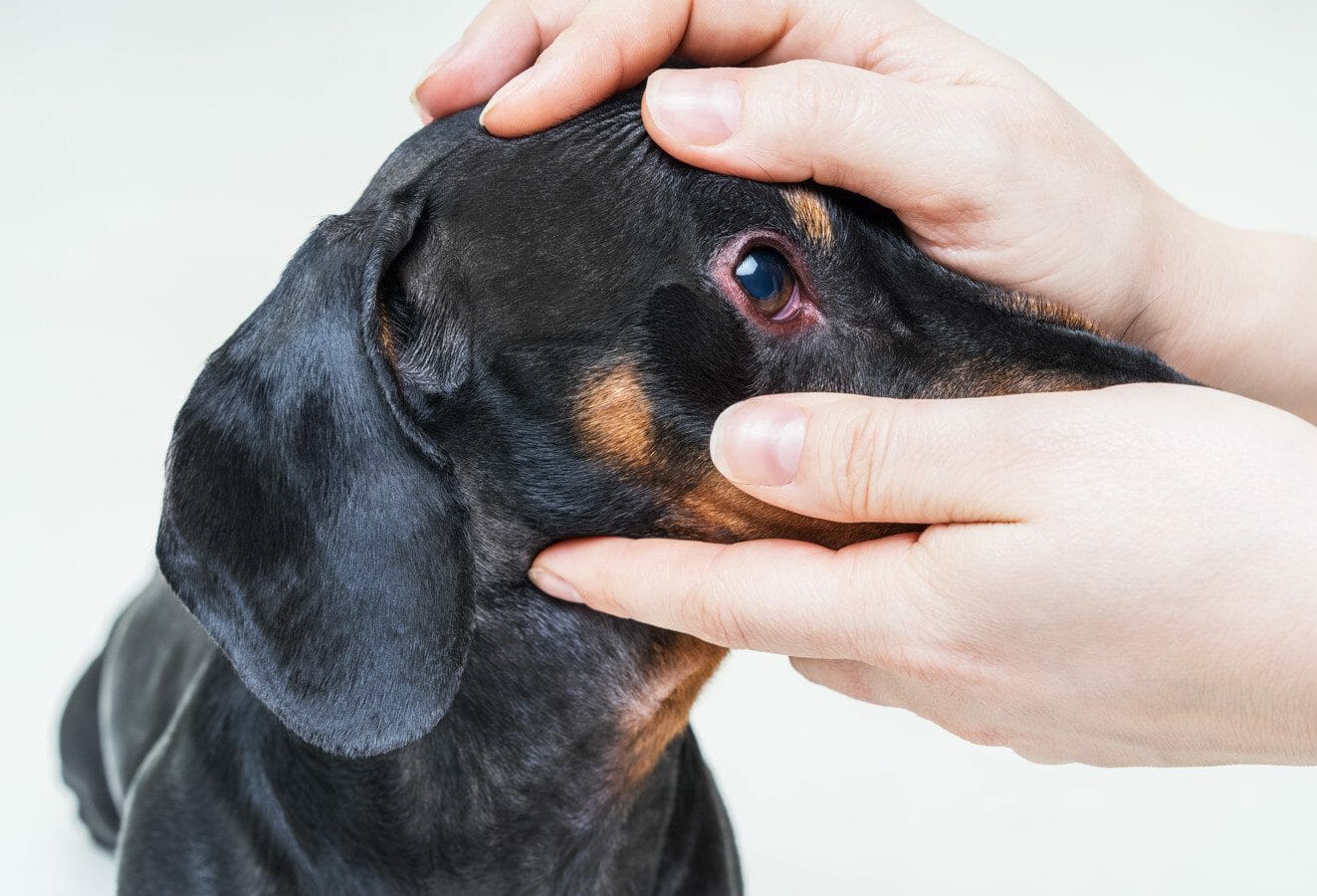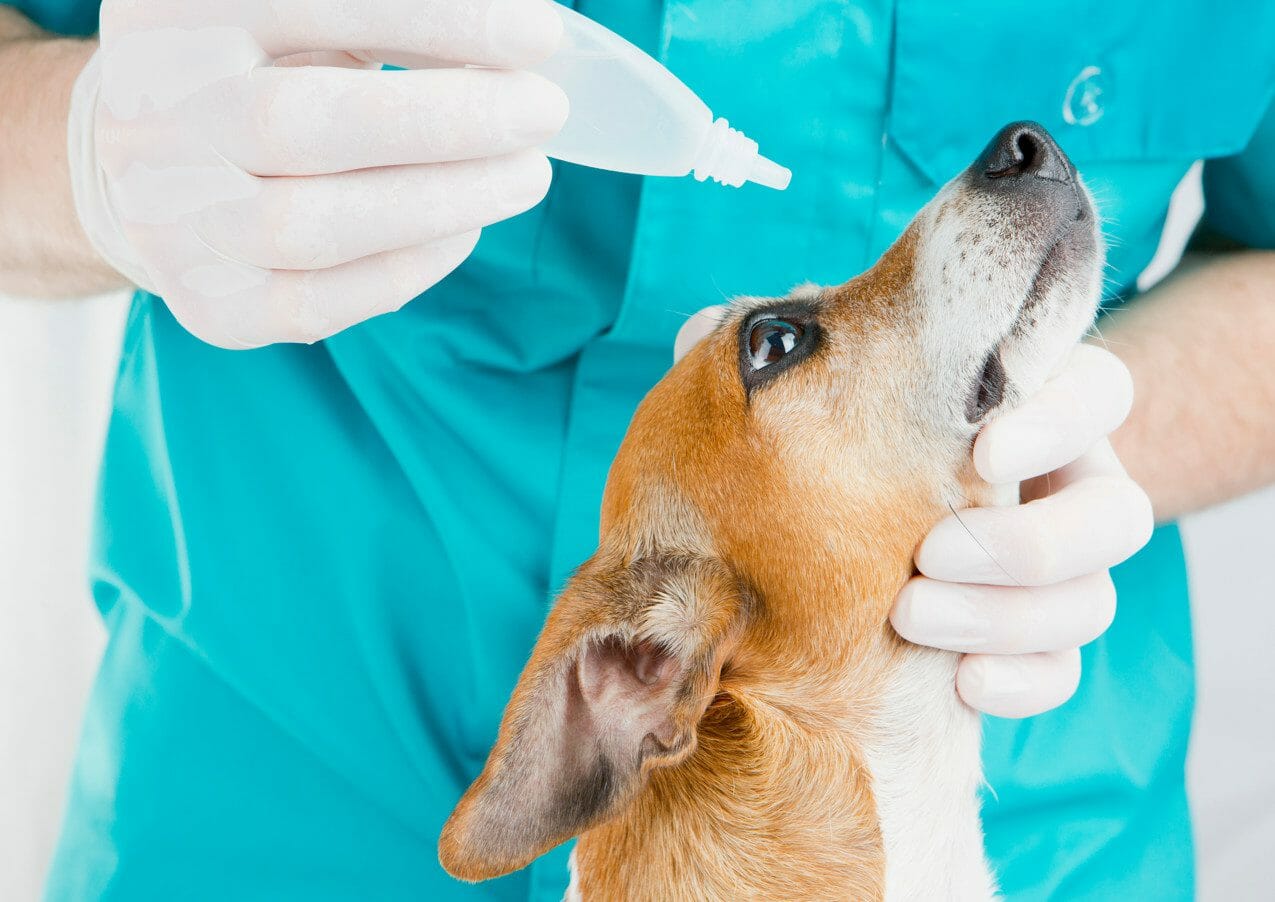Can Dogs Get Pink Eye?
Conjunctivitis in dogs (also known as dog pink eye) refers to inflammation of the conjunctiva tissue. The conjunctiva is a mucous membrane that lines the eyelid and covers the eyeball. The conjunctiva is made up of epithelial cells and is like the lining of the inside of the mouth or nose.
The purpose of the conjunctiva is to protect the eye from foreign objects or infections. When a dog contracts pink eye (which is quite common), it causes the conjunctival membrane to swell up and become red.
Pink eye in dogs should not be confused with cherry eye, which can present with very similar symptoms. Cherry eye refers to prolapse in the nictitans gland, which can result in inflammation and itchiness.
When pink eye is diagnosed early, a dog will usually make a full recovery in a relatively short period of time. However, untreated conjunctivitis in dogs may result in permanent damage to the dog’s eyes.

Conjunctivitis in Dogs Symptoms
Symptoms of Dog Pink Eye
- Weeping eyes
- Green or clear discharge surrounding the eye
- Swelling in the areas around the eye
- Whites of the dog’s eyes become red and bloodshot
- Pawing at infected eye
- Squinting or blinking
It is important to know that many of these signs could be an indicator of another eye condition, and a veterinarian will be able to carry out a thorough diagnosis. Often, dog pink eye will start in one eye and spread to the other. If the infection is due to an allergy or a virus, conjunctivitis may be present in both eyes from the outset.

What Causes Conjunctivitis in Dogs?
Owners may wonder “How do dogs get pink eye?” The simplest answer is that dogs enjoy exploring and sniffing out new places. However, in doing so, the eyes are perfectly placed to become exposed to bacteria, dust, grass seeds, and dirt. When a foreign object finds its way into a dog’s conjunctiva, it can often lead to irritation, which can lead to red, swollen, and weepy eyes.
In addition, there are several other common conjunctivitis in dogs causes, such as:
- Smoke
- Mold
- Pollen
- Ulcers
- Dry eyes caused by insufficient tear production
- Injury to the area surrounding the eye
- Other eye problems including cataracts, glaucoma, or tumors
- Uveitis (inflammation of the eyeball)
- Getting shampoo in the eye
- Eyelids that turn inward (entropion) or outward (ectropion)
- Mites that affect the skin surrounding the eyes
- Viral infections
- Bacterial infections
Many of these irritants or conditions will have no outwardly visible signs. This means it will not be possible for a dog owner to identify the reason for the problem without a veterinarian examination. It is important to determine the cause of dog pink eye so that the appropriate treatment can be provided.
While waiting for an appointment with a veterinarian, saline eye drops that are designed for dogs can be administered to attempt to flush out the irritation and alleviate some of the itchiness.

How to Diagnose Conjunctivitis in Dogs
Regardless of how mild the symptoms of dog pink eye are, it is important to seek veterinarian advice. A simple examination of the eye will be able to determine the presence of conjunctivitis. However, the veterinarian will want to examine the eye further to ensure that there has been no lasting damage and to identify the underlying cause.
The veterinarian will also want to assess the eye’s tear production to ensure that it is normal. This can be done with a straightforward test. If any foreign bodies are present in the eye, the veterinarian will remove them.
If there are no signs of improvement after the first few days or if the symptoms have worsened, the veterinarian will carry out further tests. This will include taking a swab from the conjunctiva to look for infection. The veterinarian may also carry out a blood test to rule out more serious conditions.
Where no infection is present, the veterinarian may remove a sample of cells from the dog’s conjunctiva. These cells are obtained by scraping the conjunctiva’s surface using a spatula or cotton swab. For larger samples, a surgical procedure may be performed to remove a section of the conjunctiva.

How to Treat Conjunctivitis in Dogs
The exact method for how to treat pink eye in dogs will vary depending on the cause determined by the veterinarian.
Dog Pink Eye Treatment
- Eye drops. Bacterial conjunctivitis in dogs can typically be treated using eye drops that contain antibiotics.
- Antihistamines or steroids. These medications are frequently used to treat allergic conjunctivitis in dogs. The inflammation should clear up within a few days.
- Surgery. If a tear duct is blocked, the veterinarian may recommend surgery. In addition, antibiotic eye drops may also be prescribed.
- Removal of the foreign object. This will usually be carried out while the dog is sedated.
While recovering from dog pink eye, it may be necessary for the dog to wear an E-collar to prevent pawing or scratching of the eye as this may cause further irritation. If the conjunctivitis is causing soreness to the dog, pain medication may also be given.

How to Prevent Conjunctivitis in Dogs
Many of the causes of dog pink eye can be avoided. For example, it is possible to:
- Minimize exposure to airborne irritants, such as perfumes, dust, and smoke.
- Monitor dogs playing together to help reduce the chances of eye trauma.
- Keep up to date with the dog’s vaccination schedule.
- Keep infected dogs separated from others until health is restored.
Where dogs are frequently around other animals, it can help to wipe its face whenever bringing the pet home. Additionally, washing hands after touching the dog’s face, toys, and food bowl will also help prevent the spread of infection.
Is Conjunctivitis Contagious in Dogs?
Cases of viral conjunctivitis can be contagious, and the virus may spread to other dogs. While a dog has the condition, it is important that it be kept separate from other animals until the infection is gone.
Dog owners may also wonder “Can you get pink eye from a dog?” Although extremely rare, it is possible to contract bacterial conjunctivitis from a dog. For this reason, it is essential to ensure that good hygiene is always practiced, which means washing hands after touching a dog’s face and refraining from touching the face and eyes.



